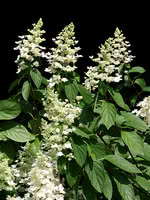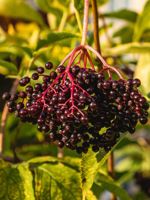Mon-Fri 9am - 5pm Mountain time
Phantom Hydrangea vs Bob Gordon Elderberry
Hydrangea paniculata Phantom
Sambucus canadensis Bob Gordon
CUSTOM GROW
Phantom Hydrangea is a striking deciduous shrub with impressive blooms. It is multi-stemmed and produces pale green flowers that fade to white and soft pink as they mature. These flower clusters can reach up to 15” (40cm) long and while other shrubs will droop from the flowers' weight, Phantom Hydrangea has sturdy stems that support them.
This adaptable shrub will make a beautiful addition to your yard as a flowering hedge or as an ornamental plant on its own. Try pruning the flowers after they are spent to get even larger flower heads.
Bob Gordon Elderberry is a Black Elderberry cultivar that produces berries that are larger and sweeter than other varieties, making it one of the top cultivars. It produces large clusters of white flowers that turn into large clusters of dark purple to black berries. The berries are well-suited for baked goods, jams, jellies, and syrups. It was selected from the wild in Missouri.
The large berry clusters that the Bob Gordon Elderberry produces will often end up hanging downward. This makes it more difficult for birds to feed on the berries. If birds are a concern, this might be the right berry for you.
Black Elderberries are considered to be partially self-pollinating. So while they will still produce some berries without cross-pollination, planting with another variety will increase yields. Consider planting with Black Elderberry or Ranch Elderberry.
Warning: the seeds, stems, leaves, roots, and uncooked berries are toxic to humans when eaten in quantity. Berries should be cooked to make them safe for human consumption.
Phantom Hydrangea Quick Facts
Bob Gordon Elderberry Quick Facts
Toxicity: leaves, stems, and uncooked berries are poisonous to humans

